“He is an extraordinary footballer who understands everything.”
Quique Setién has been a huge admirer of Brazilian midfielder Arthur Melo ever since Setién made his way to the Camp Nou in January. The 23-year-old former Gremio man has easily been among Barcelona’s best players since his arrival and it’s quite obvious that Setién sees Arthur as a vital part of his squad in days to come. The Brazilian has easily been one of the best players for Barcelona recently and is a firm and ‘long-term’ prospect to make Quique Setién’s system work properly.
In this scout report, we’ll do a tactical analysis of Arthur Melo’s profile and significance under Quique Setién. Keeping Quique Setién’s tactics and philosophy in mind, this analysis will unfold the tactical aspects that Arthur will enhance, his capabilities that contemplate Setién’s system and how Setién can aim for midfield superiority with Arthur.
An overview of Arthur’s current attributes and evolution
After arriving at Barcelona for € 31 million in summer 2018, Arthur has been a regular starter for Barcelona whenever he’s been fit and available. Known for his vision and gifted ability to play in possession, Barcelona’s quest to find another ‘Chameleon Eyes’ ended up in Arthur.
Arthur has featured as an eight for Barcelona although he played as a defensive midfielder in Gremio. His heatmap suggests his preference and the area of operation lies to the left predominantly, inclining towards the centre.
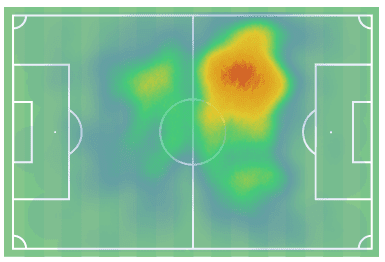
The claim, until now, seems to be justified. Despite starting fewer games due to injuries this season, Arthur still places himself into an elite category when it comes to pass completion rates, forward passes and attacking moves when compared to midfielders around Europe’s major leagues. The attributes that Arthur stands out in – getting hold of the ball, moving the ball horizontally as well as vertically and maintaining passing accuracy seem to match Setién’s possession-based approach perfectly. With 90.88% pass completion, Quique Setién can see a reliable carrier of the ball in his functioning possessional play. Similarly, the diagram below further justifies that Arthur consistently ranks among the best central midfielders in attacking attributes.
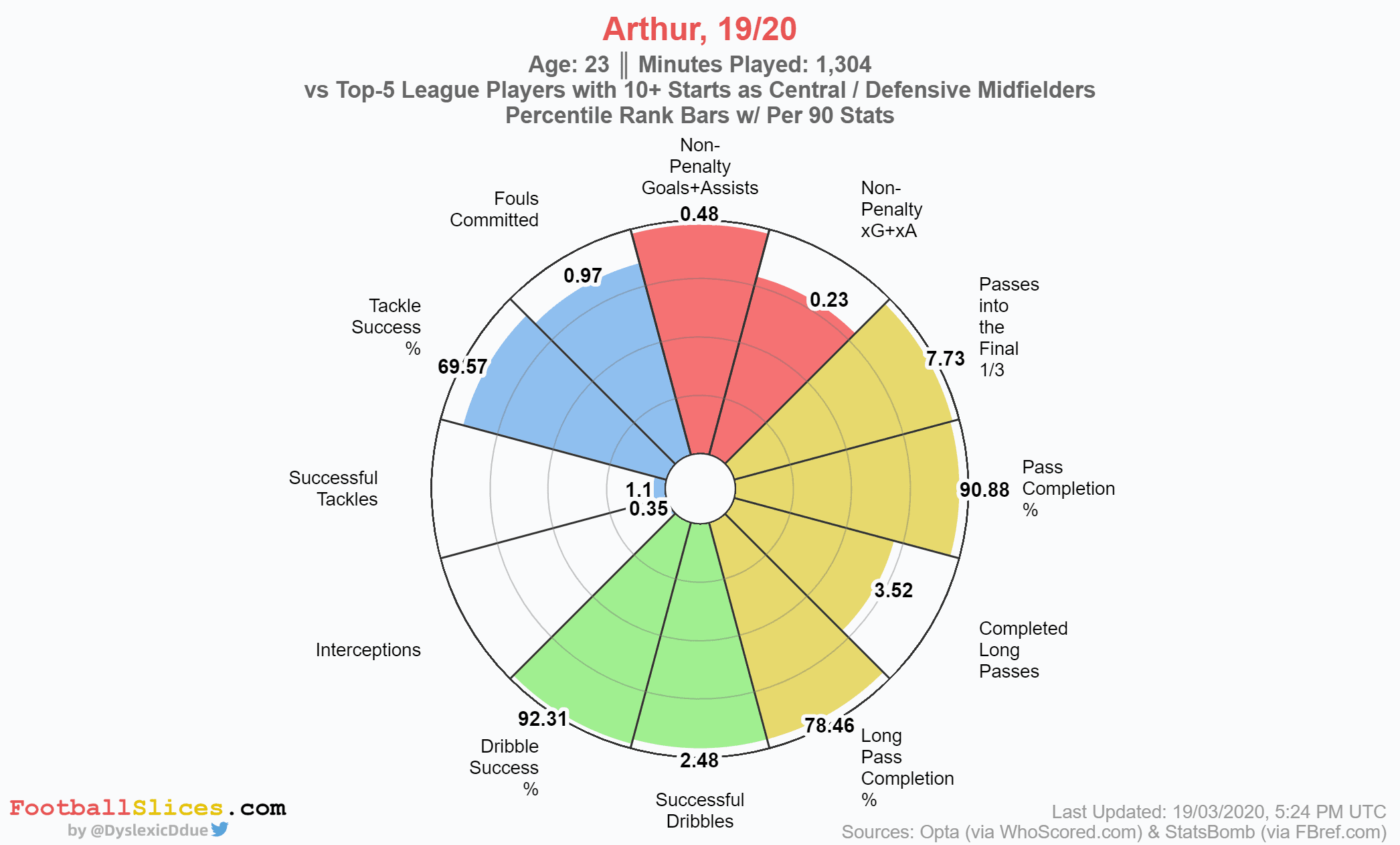
After a stellar first season under pragmatic Ernesto Valverde, Arthur has sprung into action this season despite missing a handful of matches due to injuries. However, the young Brazilian has evolved a lot in this period of time and has hence made noticeable evolution in his gameplay and attributes.
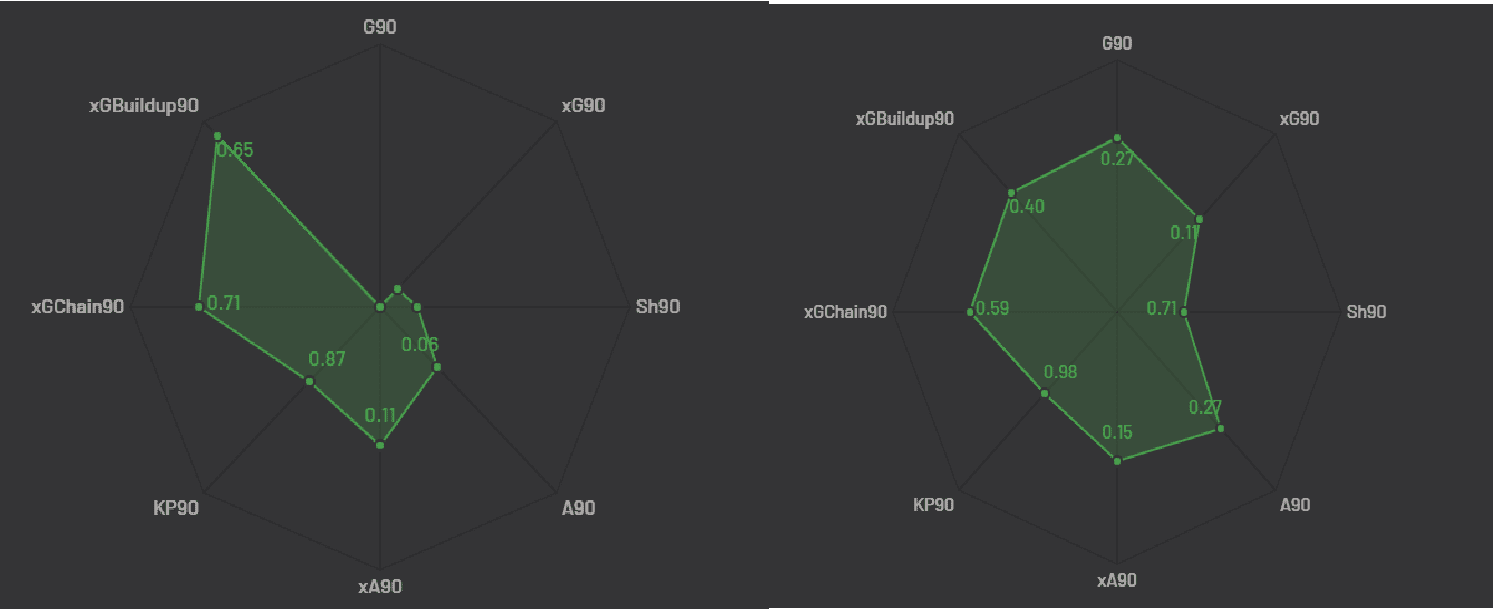
Comparing his attributes for the 2018/19 season (left) and the current season (right), Arthur’s all-round development can be observed. During 2018/19 and half of the current season at Barcelona, Arthur played under a comparatively pragmatic system, thereby not allowing him to freely make use of his playmaking abilities. Similarly, Barcelona were often dominated by sides with higher pressing lines, making it even more complex for the Brazilian to open up and maintain the tempo of the possession.
However, after 11 appearances under Setién, Arthur’s xG per 90 and xA per 90 have climbed, indicating the Brazilian can yield numbers under a system that he fits in. Similarly, the total xG of possessions that have Arthur’s involvement has seen an increase, suggesting Arthur will be a vital weapon to create goal-scoring chances and split defences in the coming future.
Quique Setién’s system and Arthur’s positioning superiority
‘Arthur is Barcelona’s next Xavi.’ Everyone that has observed Arthur Melo hold the ball, turn and pass the ball comes to a prediction about Brazilian’s close resemblance to the Blaugrana legend. The similarity becomes even more obvious when we consider Setién in this equation as Xavi, who rose to the throne under Guardiola, played under the same ideology that Setién had re-ignited to the Camp Nou.
In simple terms, keeping the ball with you, hiding it from the opponent, tempting the opponent and opening up spaces to penetrate is what Juego De Posicion is based on. Setién’s approach of football requires technically gifted and positionally aware players to work at its fullest. Arthur in this regard is one of the most prolific and compatible players that we can find today.
Barcelona’s system includes the formation of little triangles throughout the opposition pitch when in possession, to positionally create advantage and multiple passing options for everyone with/around the ball. Creating triangles contribute to better ball protection, a better connection via midfield to explosive forwards like Luis Suarez, Antoine Griezmann and Lionel Messi. Hence, the need for a midfielder that can balance the time and space equation is inevitable.
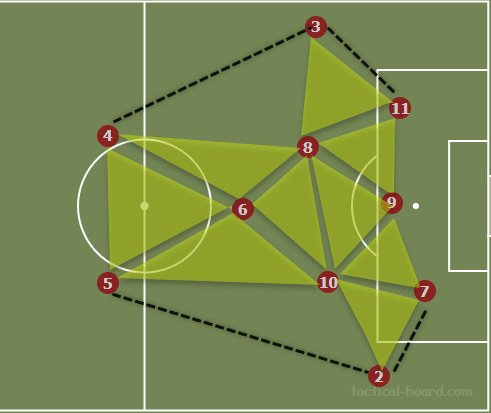
As a player who loves to demand and work with the ball, Barcelona with Arthur can have a player that can spot players when he’s on the ball, as well as position himself for the ball carrier to spot him. Possession-based Barcelona tend to rely a lot on reducing spaces while they penetrate in the opposition half and Arthur, with and without the ball, is able to reduce space between him and his potential passing option with the ball.
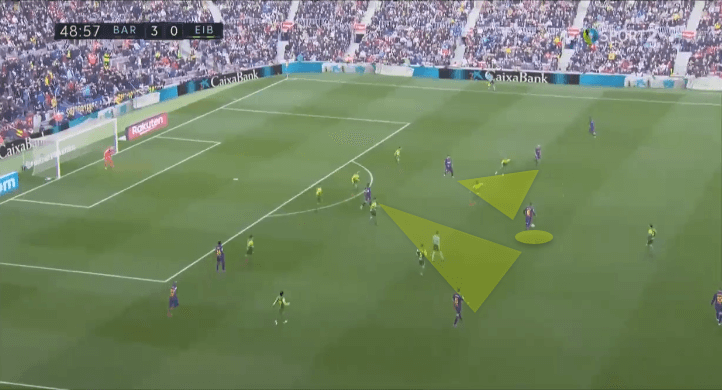
Similarly, without the ball, Arthur tries to get into the centre of the pitch, from zone 10 towards zone 11 to get as close to the ball as possible. As a result, we can see a healthy interchanging of passes between effective zone 14 players like Lionel Messi and Arthur whenever the former Gremio man is on the pitch for Barcelona.
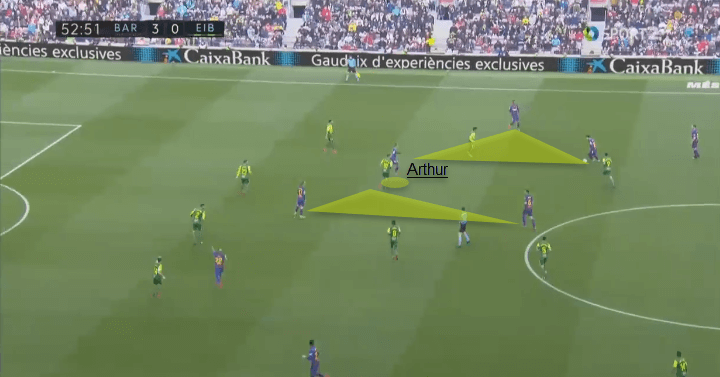
Arthur’s positioning is a quality that Quique Setién will be excited to exploit more and use him to mature even more. However, provided that Arthur is just 23 and can still develop as a player, Quique Setién will be looking forward to injecting positional discipline to reduce chances of getting caught in midfield during counters.
Building from the back and Arthur’s role
Quique Setién’s side and Barcelona, in general, are known for building out from the back. However, any team like Barcelona should have an adaptational alternative option that should be present to counter how oppositions press. Since Barcelona do not have players that possess superior physique to receive aerial balls from the keeper during the buildup, the side has to find a man who receives from the centre as the centre-backs draw the pressing opposition players.
In many regards, Arthur can be a player that is able to play with interchanging player positions, can hold the ball and find options using pauses and turns. Hence, for Quique Setién’s adaptational approach, Arthur’s capabilities fit in. With high pressing sides like Getafe prominent in the league, Setién’s advent to domestic superiority can be enhanced with a profile like Arthur (or even Frenkie de Jong).
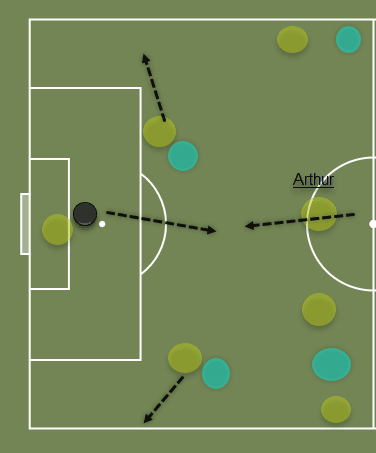
Similarly, the use of width via horizontal play helps a lot to stretch the defence and find spaces to penetrate. Lack of a midfielder that is not able to spot and use horizontal spaces to shift play can result in a complete system failure. The missing piece of the puzzle here, for Setién’s Barcelona, can be Arthur, who is able to detect the runs and spaces created by out of position players.

In the instant shown above, Arthur demonstrates a perfect-fit skill set, drawing players towards him. This might seem risky to execute but Arthur’s repetitive practice and his talent let him do these more often. Drawing the players entirely to his left side, he creates a trap for himself which he can use to his team’s advantage. He does so by detecting the space created on the other side and the run-making teammate, Lionel Messi. By making a pass to the space, Arthur is able to effectively create a lethal finishing situation that will yield a high xG for a player of Messi’s calibre.
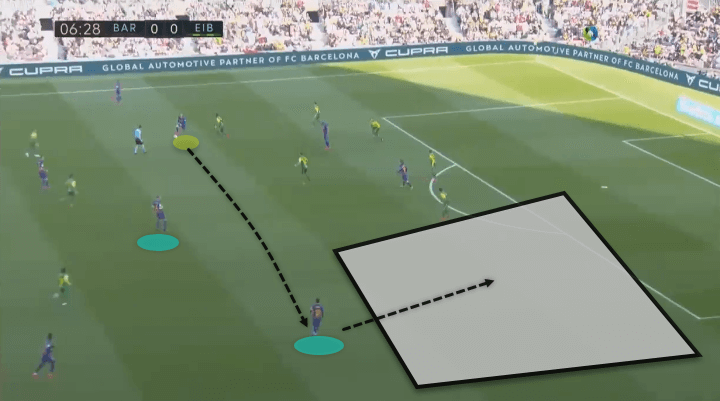
Similarly, Arthur is able to combine with his corresponding full-back to organize supply from the wide areas in addition to the diagonal balls we talked about earlier. Since Quique Setién has diverse options to choose from, Arthur has made several cameos from the left side under Setién, as a midfielder that supplies forward more than the other side occupied by Ivan Rakitic. Hence, not only does the ability to execute diagonal passes comes vital but Arthur’s awareness of managing to spot the run making full-backs that are free will be vital for Setién’s horizontal route to move the opponent structure.
Arthur’s possessional skills and attacking capability
Coming from the land that accumulates dazzling and skilful attackers, Arthur Melo is unique due to his technicality that almost makes him resemble a European midfielder. Abilities such as the use of the body to deceive opponents, use of pauses and faints to open spaces as well as interchanging passes to get rid of central blocks make him a system player tailor-made for Barcelona. Under Quique Setién, he can further display his charisma as the tenure has just started.
What makes him promising is his ability to maintain pass accuracy despite being one of the players that attempt the most number of advanced passes while on the pitch. Arthur boasts 67.8 passes per 90 with an accuracy of 91.75% (a Xavi-esque figure).
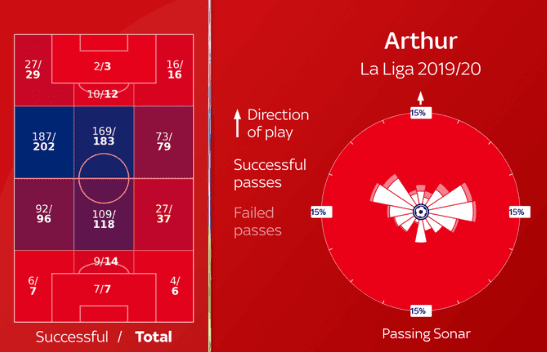
Looking at the pass distribution around the pitch and accuracy, it’s fair to conclude that Arthur is a versatile midfielder inside the Setién’s system. The deficiency of passes in the final third and zone 14 are because of the pragmatic system that restricted midfield effective connection from midfield to attack as well as may well be because of attackers themselves coming deep to fetch passes and drive forward.
Similarly, Arthur, in addition to a capable playmaker, is an attacker that is able to make runs, penetrate and shoot as well. Against tight teams that defend in numbers and man-mark the forward players, Arthur can be a surprise element that triggers runs and shoots. This will add to Setién’s approach of avoiding predictability and inducing dynamism in attacking schemes.
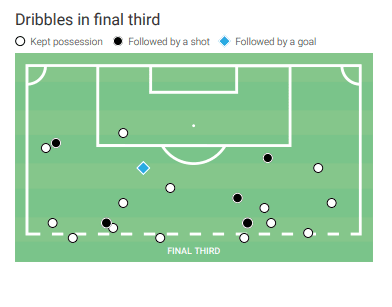
Arthur’s dribbles in the final third clear the case and ensure the idea of him as an attacking element. The 23-year-old has 20 successful dribbles in the final third, with a success rate of 83%. The remarkable thing here is that the dribbles normally come as an advanced pass for the fellow player, or a shot at goal. With this level of awareness of when to go out for a shot and when to pass, Arthur truly holds a place at Setién’s Barcelona and promises to strengthen Barcelona side.
Similarly, the Brazilian is often seen making progressive runs whenever he gets the ball with the space in front of him. In this case, the Brazilian bursts into a run, allows attackers to come to support him and make the most out of the situation. This awareness not only allows Barcelona to take advantage of space ahead but puts them in advantage higher up the pitch on counters.
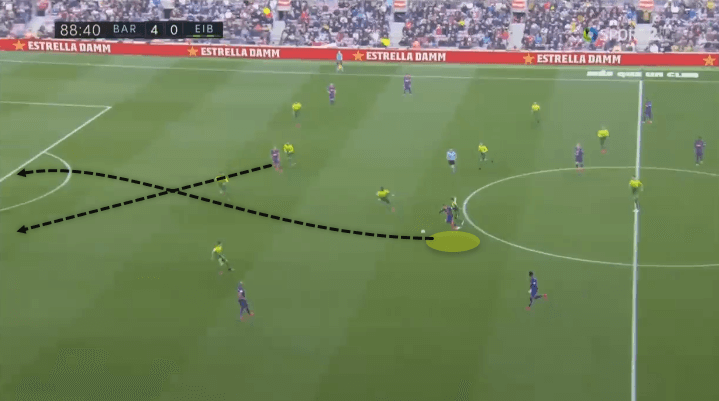
In the instant shown above, Arthur is seen receiving the ball around the middle of the pitch. Notice that there is a vertical space in front, and Arthur makes the most of the space that is formed by horizontal movement of opposition defence. In the meantime, Martin Brathwaite makes runs drawing defenders towards him, freeing Arthur to execute a one-two with him. The move ends with an Arthur Melo goal.
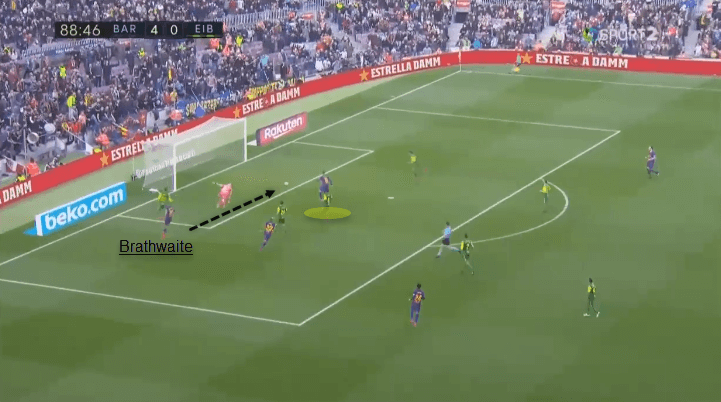
A player who can execute ‘La Pausa’ yet drift into spaces and compensate for run making forwards to arrive and deliver can definitely be an asset to a Total Football disciple like Setién. Hence, Arthur can see himself staying, despite all the speculations in the air.
The de Jong – Arthur co-existence paradox
Another talent that made his way into the Barcelona side this summer was Frenkie de Jong, one of the most technically gifted midfielders of this generation. After playing as a double-pivot in Ajax’s fairytale season and displaying a mouth-watering performance throughout the season, Frenkie has finally met a coach of his type in Quique Setién. The question here is, can Frenkie and Arthur exist in the same team under Setién?

The question comes from the fact that both the players resemble each other so much when their attributes are compared. In a 4-3-3, both Arthur and Frenkie have started out as an eight and prefer to be an eight in that formation. With Arthur’s injury concerns, Quique Setién too has opted for a midfield of Frenkie de Jong, Sergio Busquets and Ivan Rakitic more often. Hence, on papers, it is difficult to adjust both the players in the same team, especially for building a system, not a team full of stars. What seems clear, as of now, is that Arthur Melo is favourable than the current starter Ivan Rakitic and can be an option provided that Setién benches Rakitic and integrates both de Jong and Arthur in the team.
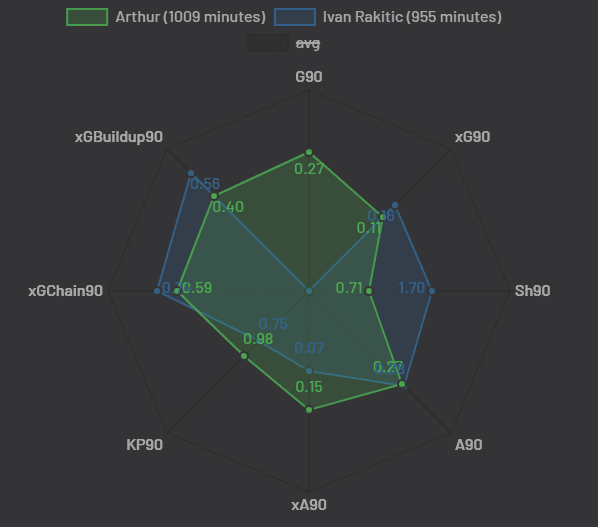
With Sergio Busquets a permanent figure as the sole defensive midfielder as of now, opting for a 4-3-3 will see both Arthur and Frenkie start as an eight and a ten respectively. This instance was experimented by Setién against Getafe, where he started de Jong towards the right. Against a high pressing Getafe, the scheme was successful and the Blaugrana were able to nullify Getafe’s approach.
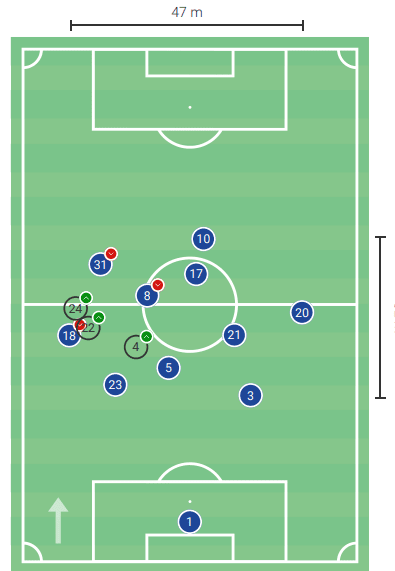
Ideally, a defensive midfielder like Busquets, a ball carrier like either de Jong or Arthur and an attacker like Carles Alenya or Riqui Puig with an electrifying physical midfielder like Arturo Vidal coming from the bench would be perfect on paper. However, considering the fact that Xavi and Iniesta too were once regarded to have too many similarities between them, we’ll have to wait and see how Setién incorporates and manages de Jong and Arthur. It all comes down to the manager’s approach now, how he will make the most out of two of the most talented and potential midfield stars in years to come for Barcelona.
Conclusion
Quique Setién’s love for Arthur is obvious: he sees him as a part of his plan. Barcelona, after multiple attempts to replace Xavi, have finally found a profile that can provide them with a benchmark to midfield dominance yet again. What makes it more obvious is that they’ve found a manager who loves to dominate the pitch, play the ball quickly and get every ounce of what his technical players have for him.
As the tactical analysis pointed out, Arthur certainly has the Barca DNA that fans have waited after Xavi’s departure. For now, Quique Setién will be home, figuring out his chess-led philosophies to make the most out of his team and uplift the system using the man himself: Arthur Melo.

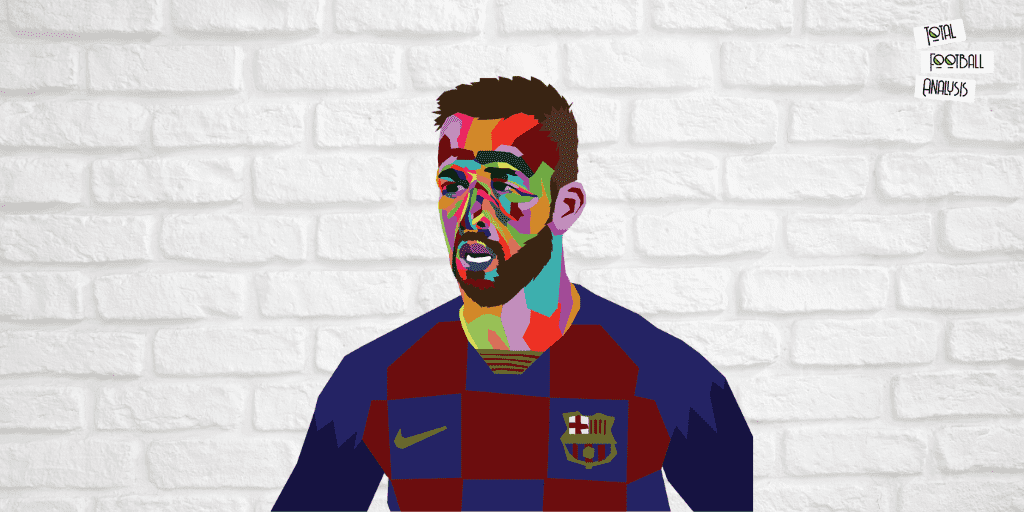



Comments